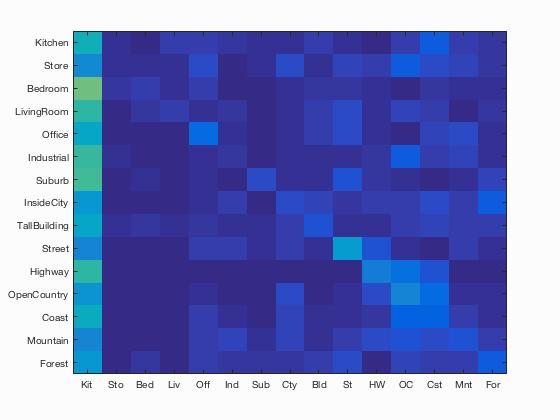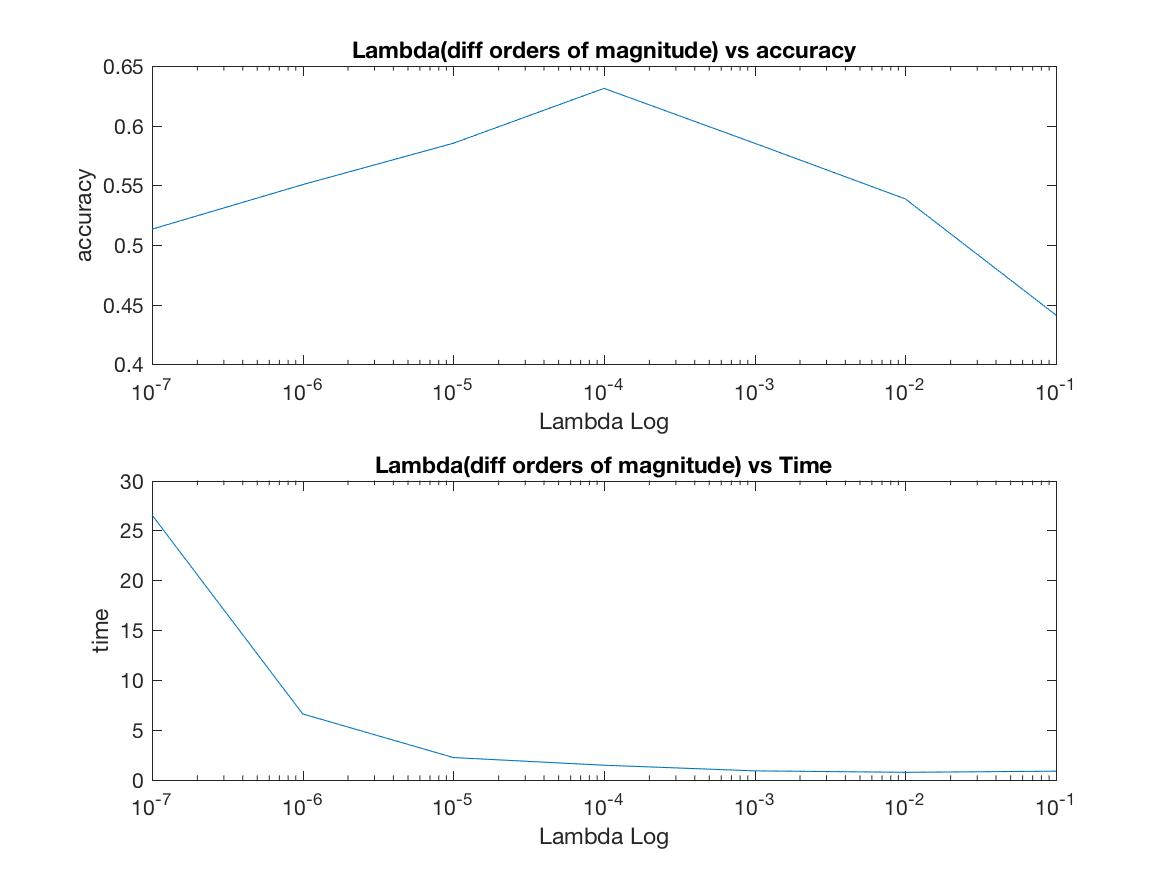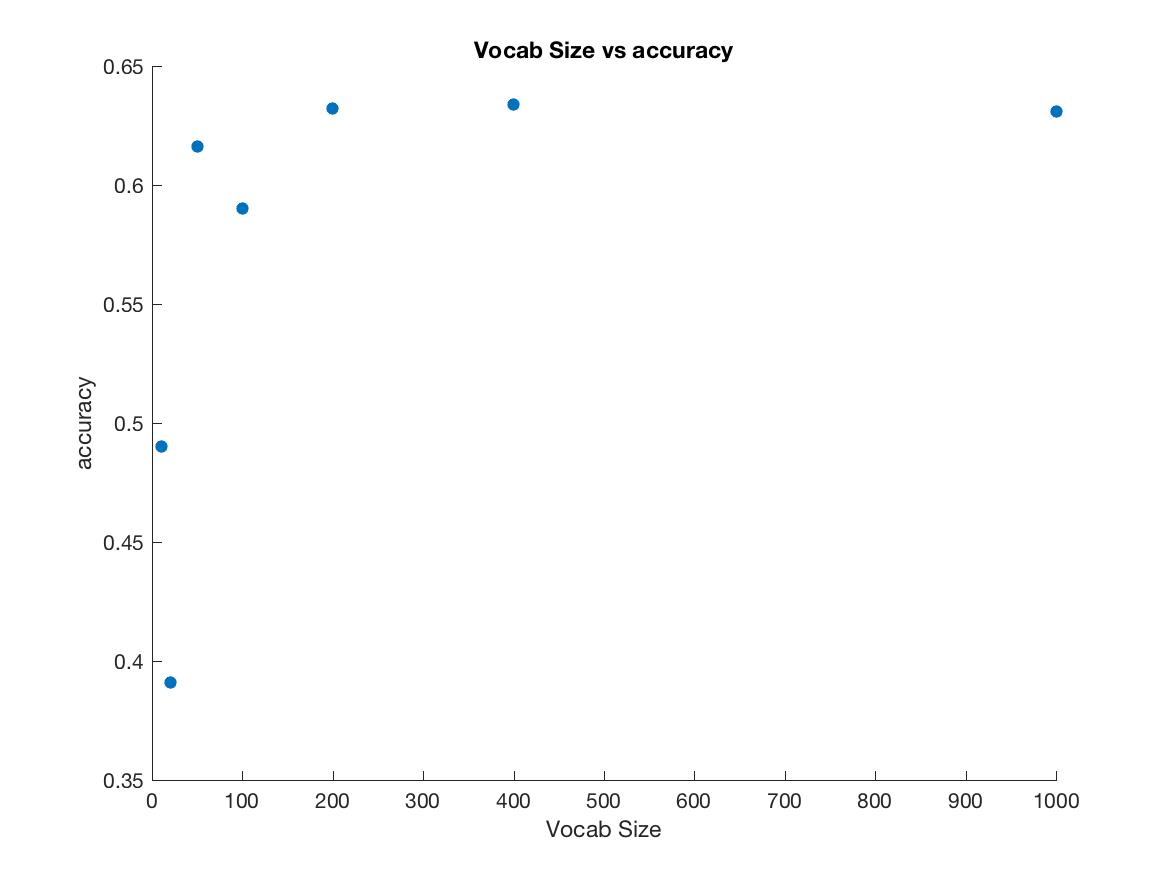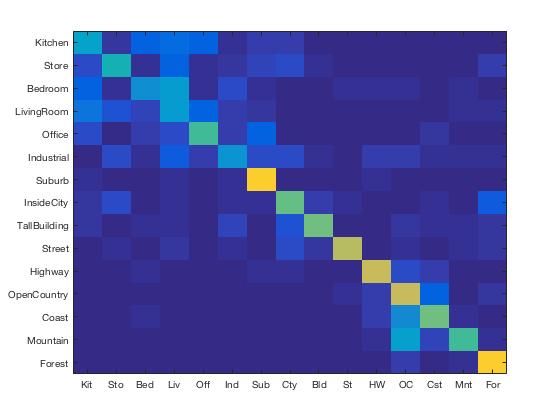Project 4 / Scene Recognition with Bag of Words

Example scenes from of each category in the 15 scene dataset. Figure from Lazebnik et al. 2006.
My scene recognition pipeline has two parts. I used the 15 scene dataset and implemented the following:
Part 1: Feature Extraction
This consists of going through the training and test sets and extracting the relevant features. I experimented with three feature representations:
- Tiny image representation. Originally created by Torralba, Fergus, and Freeman. I simply resized each image to 16x16 and used the 256 pixels as a feature. I experimented with normalizing the features and making their mean 0.
- SIFT Features
- gist descripters. I used the gist decripters originally implemented by Aude Oliva, Antonio Torralba.
Part 2: Machine Learning
With the features in hand, I set out to classify them. I used two classification algorithms:
- Nearest Neighbor
- Linear Support Vector Machine
Experiments
I performed the following experiments:
Tiny Image with Nearest Neighbors
Here, I ran tiny image with slight variations and then used nearest neighbors on those features.
The variations are:
- Just 256 pixels. The results were:
Using tiny image representation for images
Elapsed time is 12.498010 seconds.
Using nearest neighbor classifier to predict test set categories
Elapsed time is 1.961715 seconds.
Accuracy = 0.191
This was expected. You can see the full results here.
- Just 256 pixels, but with normalization. I normalized the features to unit length. The results were:
Using tiny image representation for images
Elapsed time is 12.452074 seconds
Using nearest neighbor classifier to predict test set categories
Elapsed time is 1.543277 seconds.
Accuracy = 0.199
This was expected. I got a small boost in performance (0.199 vs 0.191).
I did not expect it to take slightly less time, although I might be reading too much into it.
You can see the full results here.
- Just 256 pixels, but with normalization and zero mean. I normalized the features to unit length and set the mean to 0 by subtracting the old mean from each element in the feature. The results were:
Using tiny image representation for images
Elapsed time is 12.946300 seconds.
Using nearest neighbor classifier to predict test set categories
Elapsed time is 1.083529 seconds.
Accuracy = 0.147
This was very unexpected. I got a considerable loss in performance (0.147 vs 0.191) and it took longer to run.
You can see the full results here.
Bag of SIFT with Nearest Neighbors
I first ran SIFT with a vocab size of 200 and step size of 10. Results:
Using bag of sift representation for images
Elapsed time is 244.782265 seconds.
Using nearest neighbor classifier to predict test set categories
Elapsed time is 2.066009 seconds.
Accuracy = 0.513
Confusion matrix
 This was expected. As you can see, the creating a vocabulary and extracting SIFT features too about 4 minutes.I got an accuracy of 51%
This was expected. As you can see, the creating a vocabulary and extracting SIFT features too about 4 minutes.I got an accuracy of 51%Bag of SIFT with Linear SVMs
Again, I used a vocab size of 200 and step size of 10. I varied Lambda to get the best performance.
First I went through orders of magnitude, going from 0.1 to 10^-7. The results were:
| Lambda |
10^-1 |
10^-2 |
10^-3 |
10^-4 |
10^-5 |
10^-6 |
10^-7 |
| Accuracy |
0.4413 |
0.5387 |
0.5853 |
0.6313 |
0.5853 |
0.5507 |
0.5133 |
| Time (s) |
0.8738 |
0.7585 |
0.9060 |
1.470 |
2.2398 |
6.6108 |
26.5470 |
Plotting these:
 As you can see, there is a clear peak at 10^-4. So I started fine tuning.
I ran it again but with Lambda varying from 0.0001 to 0.0009 in increments of 0.0001.
As you can see, there is a clear peak at 10^-4. So I started fine tuning.
I ran it again but with Lambda varying from 0.0001 to 0.0009 in increments of 0.0001.
| Lambda |
0.0001 |
0.0002 |
0.0003 |
0.0004 |
0.0005 |
0.0006 |
0.0007 |
0.0008 |
0.0009 |
| Accuracy |
0.6287 |
0.6247 |
0.6180 |
0.6100 |
0.5987 |
0.5987 |
0.5967 |
0.6027 |
0.5953 |
| Time (s) |
1.212 |
1.0172 |
0.8319 |
0.8044 |
0.8769 |
0.8388 |
0.8402 |
0.7931 |
1.0674 |
Plotting these:
 Since 0.0001 performed the best, I used that value for future experiments.
After this, I varied the vocab size. I experimented with parallel processing by using parpool to create a cluster locally and then using parfor loops. The result was
Since 0.0001 performed the best, I used that value for future experiments.
After this, I varied the vocab size. I experimented with parallel processing by using parpool to create a cluster locally and then using parfor loops. The result was
| Size |
10 |
20 |
50 |
100 |
200 |
400 |
1000 |
| Accuracy |
0.490 |
0.391 |
0.616 |
0.590 |
0.632 |
0.634 |
0.631 |
 Here is the confusion matrix for Lambda = 0.0002 and Vocab Size = 400:
Here is the confusion matrix for Lambda = 0.0002 and Vocab Size = 400:
 The accuracy was 0.627 .You can see the full results here.
The accuracy was 0.627 .You can see the full results here.
gist with Nearest Neighbors
Using only gist features, I got a small increase in accuracy.
Results:
Using bag of gist representation for images
Elapsed time is 308.598544 seconds.
Using nearest neighbor classifier to predict test set categories
Elapsed time is 4.023655 seconds.
Accuracy (mean of diagonal of confusion matrix) is 0.561
Confusion matrix
 Creating gist features took longer to extract than SIFT (5 minutes vs 4 minutes). There was a 3% increase in accuracy.
Creating gist features took longer to extract than SIFT (5 minutes vs 4 minutes). There was a 3% increase in accuracy.
gist with Linear SVMs
I varied Lambda to get the best performance.
First I went through orders of magnitude, going from 0.1 to 10^-7. The results were:
| Lambda |
10^-1 |
10^-2 |
10^-3 |
10^-4 |
10^-5 |
10^-6 |
10^-7 |
| Accuracy |
0.2927 |
0.5720 |
0.6513 |
0.6913 |
0.6807 |
0.6493 |
0.6367 |
| Time (s) |
0.9898 |
0.9484 |
1.0137 |
1.5346 |
4.9265 |
17.2567 |
23.6776 |
Plotting these (Note the Y axis in the first plot is accuracy, and time in the second plot.):
 As you can see, there is a clear peak at 10^-4. So I started fine tuning.
I ran it again but with Lambda varying from 0.0001 to 0.0009 in increments of 0.0001.
As you can see, there is a clear peak at 10^-4. So I started fine tuning.
I ran it again but with Lambda varying from 0.0001 to 0.0009 in increments of 0.0001.
| Lambda |
0.0001 |
0.0002 |
0.0003 |
0.0004 |
0.0005 |
0.0006 |
0.0007 |
0.0008 |
0.0009 |
| Accuracy |
0.6967 |
0.6967 |
0.6847 |
0.6673 |
0.6573 |
0.6767 |
0.6633 |
0.6520 |
0.6687 |
| Time (s) |
1.5756 |
1.268 |
1.1900 |
1.1118 |
1.1181 |
1.0523 |
1.1142 |
1.1592 |
1.201 |
Plotting these (Note the Y axis in the first plot is accuracy, and time in the second plot.):
 Since 0.0001 and 0.0002 performed equally well and 0.0002 took less time, I used 0.0002 as my Lambda value for further experimetnts.
Here is the confusion matrix for Lambda = 0.0002:
Since 0.0001 and 0.0002 performed equally well and 0.0002 took less time, I used 0.0002 as my Lambda value for further experimetnts.
Here is the confusion matrix for Lambda = 0.0002:
 The accuracy was 0.687 . This is the better than bag of SIFT by about 0.07. You can see the full results here.
The accuracy was 0.687 . This is the better than bag of SIFT by about 0.07. You can see the full results here.
Combining features
Thinking the more the merrier, I first combined all the three feature representations above and classified them using SVM.
the results were dismal. I got only 9%. The confusion matrix is:
 I figured the tiny image representation might be skewing things on account of it's low information features. I combined gist and SIFT and the results were pretty good. I achieved around 77%. It achieved more than 90% accuracy for Suburb (95%), Street(91%) and Forest (92%)!
The result was:
I figured the tiny image representation might be skewing things on account of it's low information features. I combined gist and SIFT and the results were pretty good. I achieved around 77%. It achieved more than 90% accuracy for Suburb (95%), Street(91%) and Forest (92%)!
The result was:
Scene classification results visualization

Accuracy (mean of diagonal of confusion matrix) is 0.768
| Category name |
Accuracy |
Sample training images |
Sample true positives |
False positives with true label |
False negatives with wrong predicted label |
| Kitchen |
0.650 |
 |
 |
 |
 |

Bedroom |

Bedroom |

Bedroom |

Store |
| Store |
0.660 |
 |
 |
 |
 |

Kitchen |

Bedroom |

TallBuilding |

Kitchen |
| Bedroom |
0.570 |
 |
 |
 |
 |

LivingRoom |

LivingRoom |

OpenCountry |

LivingRoom |
| LivingRoom |
0.450 |
 |
 |
 |
 |

Bedroom |

Bedroom |

Bedroom |

Bedroom |
| Office |
0.890 |
 |
 |
 |
 |

Kitchen |

Bedroom |

Kitchen |

Kitchen |
| Industrial |
0.750 |
 |
 |
 |
 |

Store |

Bedroom |

Kitchen |

Store |
| Suburb |
0.950 |
 |
 |
 |
 |

LivingRoom |

Bedroom |

Kitchen |

InsideCity |
| InsideCity |
0.790 |
 |
 |
 |
 |

Highway |

Industrial |

Kitchen |

TallBuilding |
| TallBuilding |
0.880 |
 |
 |
 |
 |

InsideCity |

LivingRoom |

InsideCity |

Store |
| Street |
0.910 |
 |
 |
 |
 |

Store |

InsideCity |

Mountain |

InsideCity |
| Highway |
0.830 |
 |
 |
 |
 |

Coast |

OpenCountry |

Coast |

Bedroom |
| OpenCountry |
0.590 |
 |
 |
 |
 |

Mountain |

LivingRoom |

Coast |

Highway |
| Coast |
0.830 |
 |
 |
 |
 |

Industrial |

OpenCountry |

OpenCountry |

Suburb |
| Mountain |
0.850 |
 |
 |
 |
 |

TallBuilding |

Kitchen |

Coast |

Forest |
| Forest |
0.920 |
 |
 |
 |
 |

Mountain |

OpenCountry |

Store |

TallBuilding |
| Category name |
Accuracy |
Sample training images |
Sample true positives |
False positives with true label |
False negatives with wrong predicted label |
Weird result
I tried using
Olivier Chapelle's SVM MATLAB code with an RBF kernel but it gave me 100% accuracy every time. Something was clearly wrong. Here is the confusion matrix I got:

Results
In the end, I managed to achieve about 76.8% accuracy by combining gist and SIFT features.
I could have gotten better results by accounting for different spatial scales, using more optimized values for stepsize, image size etc. and using different SVM kernels. I will look into them in the future.
I also couldn't finish performing cross validation which would have given me a more honest idea of the accuracy of my model.
I tried running the code on GT PACE High Performance Cluster but couldn't get it working.
Data
You can see the confusion matrices and other plots I made while performing the experiments here. I did not include all of them in this webpage for the sake of brevity.




 Here is the confusion matrix for Lambda = 0.0002 and Vocab Size = 400:
Here is the confusion matrix for Lambda = 0.0002 and Vocab Size = 400:































































































































